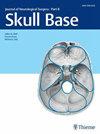Spontaneous Clival Leaks and their management
IF 0.9
4区 医学
Q3 Medicine
引用次数: 0
Abstract
Introduction: Cerebrospinal spinal fluid (CSF) leaks through the nasal cavity occurrence has a rising trend, of which primary spontaneous leak is 6%-40% of all the CSF leaks. The most common site of CSF leak is Ethmoid roof where the bone is thinner in the entire skull base. Clivus being the hard bone, is a rare site for spontaneous leak. We present a case series from a single quaternary care center of this rare occurrence and study its reason and management strategy. Materials and Methods: A retrospective surgical audit over a period of 10 years of all patients diagnosed with CSF rhinorrhea was done .A PubMed search was conducted with keywords of CSF leak, CSF rhinorrhea, spontaneous CSF rhinorrhea, clival leak, clivus to identify the literature and these articles were compiled and their management reviewed. Results and Analysis: A total of 100 patients underwent surgical management for spontaneous CSF leak of which there were 5 patients who had spontaneous CSF rhinorrhea from the Clivus. There were 4 female patients, 4 patients had high BMI. The most common site of leak was midclivus annd surgical technique employed was multilayer dural plasty with a nasoseptal flap and measures were taken to reduce the intracranial pressure intra operatively and post operatively Conclusion: Spontaneous clival leak is a rare entity with mid and lower clivus being the common site. A combined approach by ENT and Neurosurgeons results in best outcome for the patients.瓣膜自发性渗漏及其处理
简介通过鼻腔发生的脑脊液(CSF)漏呈上升趋势,其中原发性自发性漏占所有 CSF 漏的 6%-40%。CSF 漏最常见的部位是整个颅底骨质较薄的乙状顶。蝶窦是坚硬的骨头,是自发性漏液的罕见部位。我们在一家四级医疗中心对这一罕见病例进行了系列报道,并对其原因和处理策略进行了研究。材料和方法:以 CSF 漏、CSF rhinorrhea、自发性 CSF rhinorrhea、clival leak、clivus 为关键词在 PubMed 上进行搜索,以确定文献,并对这些文章进行汇编和管理回顾:共有 100 名患者因自发性 CSF 漏接受了手术治疗,其中有 5 名患者因 Clivus 自发性 CSF 鼻溢液。其中有 4 名女性患者,4 名患者的体重指数较高。最常见的漏液部位是蝶窦中段,采用的手术方法是多层硬脊膜成形术和鼻隔皮瓣,并在术中和术后采取了降低颅内压的措施:自发性蝶窦漏是一种罕见病,常见部位为蝶窦中下段。耳鼻喉科和神经外科医生联合治疗可为患者带来最佳疗效。
本文章由计算机程序翻译,如有差异,请以英文原文为准。
求助全文
约1分钟内获得全文
求助全文
来源期刊

Journal of Neurological Surgery Part B: Skull Base
CLINICAL NEUROLOGY-SURGERY
CiteScore
2.20
自引率
0.00%
发文量
516
期刊介绍:
The Journal of Neurological Surgery Part B: Skull Base (JNLS B) is a major publication from the world''s leading publisher in neurosurgery. JNLS B currently serves as the official organ of several national and international neurosurgery and skull base societies.
JNLS B is a peer-reviewed journal publishing original research, review articles, and technical notes covering all aspects of neurological surgery. The focus of JNLS B includes microsurgery as well as the latest minimally invasive techniques, such as stereotactic-guided surgery, endoscopy, and endovascular procedures. JNLS B is devoted to the techniques and procedures of skull base surgery.
 求助内容:
求助内容: 应助结果提醒方式:
应助结果提醒方式:


